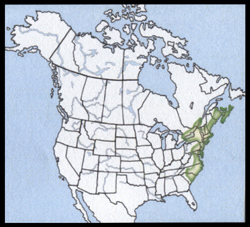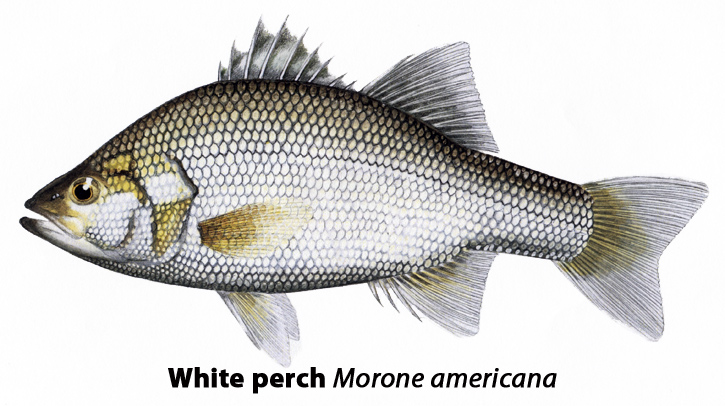White Perch, December 2013, Fish of the Month!
A Brief Note to Our Readers:
We probably don't have to tell you that with this month's installment of our Hook & Hackle Fish of the Month column, we've left the realm of the Minnow Family. The White perch is the first in our list of members of the Temperate Bass family.
(Not to worry though, there are bigger fish species waiting in the wings, so stay tuned!)
White Perch
Morone Americana
Local Names:
Wreckfish, Silver perch, Sea perch, Perch, Bass
Average Size:
5 to 10 inches
0.25 to 0.75 pound
Distinguishing Field Marks:
(See the illustration.)
-
The body, gill covers, and cheeks are completely scaled.
-
The head is concave on top, sloping up to the origin of the first dorsal fin.
-
The mouth is of moderate size, with its upper jaw extending to the mid-point of the eye.

The first dorsal fin has 9 spines and is joined to the second dorsal fin, which has 1 spine on its leading edge and 11 or 12 rays.
-
The caudal fin is moderately forked with rounded lobes of equal size.
-
The anal fin has 3 spines on its leading edge and 8 to 10 rays.
The paired pelvic fins originate under the leading edge of the first dorsal fin and have 1 spine each on their leading edges.
The pectoral fins are nearly transparent.
North American Range:
Map to the right shows approximate range in North America.
Diet:
The young begin feeding on the smallest zooplankton, then grow into consuming immature and adult aquatic insects and other invertebrates. Large adult White perch include a significant percentage of small forage fish, including their own offspring, in their diets.
Biology:
Throughout their range, when water temperatures reach 60 degrees F., mature White perch gather in shallows of either brackish or fresh water to commence the spawning season. That season may last from mid-May into late-June. No nests are prepared, instead the spawning fish form dense schools in which males and females randomly release eggs and sperm. The fertilized eggs are adhesive and sink to the bottom, where they attach to whatever they contact. The species is very prolific, with egg counts ranging from 20,000 to 60,000 per female, and this is unusual because White perch are not large fish.
The young begin actively feeding immediately on hatching.
Because they are so prolific, in favorable habitats White perch can easily over-populate and grow to only a small stunted size. This is especially true in small landlocked waters. It appears that females live longer and grow slightly larger than males. The typical White perch life span is 5 to 7 years.
Fly Fishing for White Perch:
Another relatively small but typically very abundant American fish species, White perch are unlikely to inspire anglers to specifically seek them. Nonetheless, they are often encountered by fly fishers within their strictly eastern range. As they tend to form schools, these fish can provide a youngster with plenty of opportunity to develop his or her fly fishing skills. White perch are not spectacular fighters, but make a decent account of themselves when hooked. When handling any members of this family, take care to avoid being stuck by the many sharp stiff fin spines.
Fly fishing equipment should be in the 4 to 5 weight range. White perch will take a wide variety of fly offerings, but casting or even trolling wet flies and small streamers is likely to result in the largest number of White perch hook-ups.
An important note for this species is that very young White perch can be easily confused with young Striped bass. To distinguish them, note that the 2 dorsal fins of the White perch are connected by the last membrane of the first dorsal fin, while the dorsal fins of the Striped bass are distinctly separated.
Significance to Humans:
Locally of some importance as a directly consumed food and game fish, and commercially taken in the south of its range.
Although we always recommend catch and release fly fishing, in this case you're unlikely to put even a small dent in any local White perch population by killing enough of them to make a decent fish-fry. When filleted, White perch make an excellent meal, as their flesh is firm, white, and flavorful. As an interesting side-bar, White perch are at the high end of fish flesh cleanliness, being genetically hosts to no natural parasites.
Status:
This member of the Temperate bass family seems quite able to sustain itself with no human help. That said, it should be noted here that this notoriously prolific species has recently been illegally “stocked” into one of Maine’s classic Brook trout and Landlocked salmon waters, Moosehead Lake. It’s probably safe to say that its presence there will not benefit the native fish species.
And yet another note from and to those of us who favor the long rod; illegal stocking of non-native then invasive exotic fish species may seem at a casual glance to be a good idea in the name of expanding a “fishery.” How ‘bout we leave the subject with you all this way; if you know anyone who’se thinking of self-stocking any water, please, in the strongest possible terms, discourage their going through with it. We humans have gone way too far down that road already, and we’re sure that you’ve probably heard of at least one once thriving native fish population being decimated or seriously negatively impacted by the introduction (legal or illegal) of non-native species.







